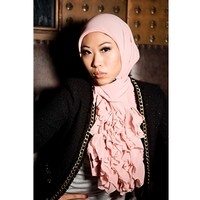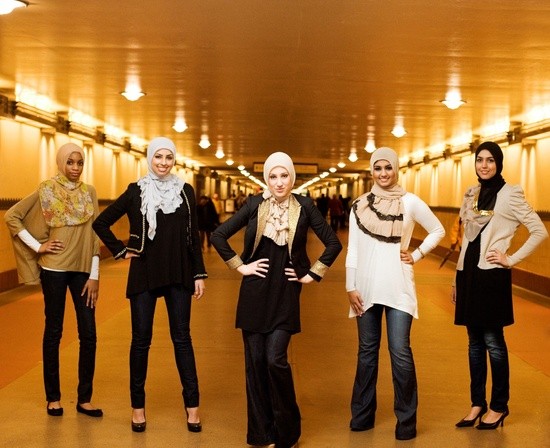
“Victorian Lace,” “Black Ruffle Prima Ballerina” and “Cat's Meow” are names of the top-selling products at Vela Scarves, a Fountain Valley-based online fashion company that produces high quality hijabs, or headscarves, for Muslim women.
“Vela is a company that takes occurring fashion trends and applies it to the headscarf while maintaining the Islamic standards of modesty,” explained Marwa Atik, the designer and co-founder of the company.
Vela, derived from the Latin word for “veil,” was established in the fall of 2009 when Atik and some of her friends created a fan page for the company and began posting the scarves on Facebook.
]
With more orders coming in than the college students could handle, Marwa
sat down with her sister, Tasneem, to create a real business plan for
the company. Since then, Vela has been registered as an official LLC,
hired a manufacturer to create the scarves and produces an average of
200 headscarves per month. They even receive international orders from
Singapore, Malaysia, Germany, Turkey and South Africa, to name a few
countries.
“This is just something that fell into my lap,” explained Atik. “I
didn't know how big Vela was going to be until I received so much
positive feedback from girls who are very fashionable but are having a
hard time practicing the hijab properly.”

In Islamic tradition, both men and women are supposed to dress
modestly so as to draw attention away from superficial attributes and to
promote respect and humility towards the opposite gender. For women,
the requirements include covering all parts of the body except the face
and hands, wearing loose and opaque clothing so as to not reveal the
outline of the body. For many Muslim girls living in the West, however,
adhering to these standards while trying not to commit a fashion faux
pas is almost impossible.
Frustrated with the limited selection of scarves that Muslim
storekeepers import from the Middle East, Atik, whose parents are from
Syria, began designing her own hijabs, adding ruffles, zippers, pleats,
beaded sequins and other elements of Western fashion.
As a nursing student at Cal State Fullerton, Atik always
found herself sketching and doodling in biology lectures. She studied
fashion magazines and stayed current on the latest releases from
designers like Marc Jacobs, Alexander McQueen and Lebanese-born Elie
Saab. With these fashion moguls as inspiration, Atik aims to prove the
compatibility of the Islamic dress code with Westernized fashion.
“American and European clothes are getting looser,” argued Atik, “we are
seeing longer dresses, sleeves on evening gowns–clothes that adhere to
Islamic standards of modesty.”
The 20-year-old designer, who is finishing her studies at
the Fashion Institute of Design and Merchandising, also takes
inspiration from her hometown and the environment in Orange County. She
says that the couture headscarves, made mostly from chiffon, silk or
cotton, are meant to be comfortable yet trendy and fashionable,
reflecting the attitudes of a Southern Californian.
“The average Vela customer is a young, Muslim woman between the ages of
18 and 30,” says Atik. “She is very sociable, goes out to events, is
involved in the community; she is fashionable, trendy and likes to
express herself in different ways.”
Though Vela receives much support from young girls in the
Muslim community (the fan page has close to 6,000 likes), the company has
been criticized by some who consider its hijab style inappropriate and
immodest.
In an October 2010 LA Times article, Eiman Sidky, a religion
teacher at King Fahad mosque in Culver City, regarded the Vela scarves
as overly adorned, defeating the purpose of the hijab because they draw
too much attention.
For her part, Alaa Alomar, a 22-year-old graduate from UC Irvine, who
owns seven of the Vela scarves, thinks that not only are the Vela
scarves “beautiful, but they also serve as a form of dawah” or a way for
non-Muslims to learn about Islam. Because of the hijabs, Alomar has
had several individuals approach her, asking questions about her faith.
When it comes to negative criticism, Tasneem Atik, the co-founder and business manager of Vela, explains that though there are set guidelines
for wearing the headscarf, the hijab itself has been left to interpretation.
“Throughout the world, there are various hijab styles, like the Turkish,
Khaliji or Iranian scarves,” stated Atik. “Vela represents all those
variations but has added Western twists and fashion trends.”
And those who have worn a Vela scarf can attest to its uniqueness. The
company has even posted various tutorial videos on how to wrap the
square- and rectangular-shaped pieces so that the patterned side renders
visible. Consequently, many Muslim girls have coined the expression,
“the Vela way” when referring to this hijab style. Even non-Muslims have
taken an interest in the scarves produced by Vela. Atik recalls one of
her friends being approached by Christian and Jewish women who
want to know where they can purchase the scarves.
This is a good sign for Atik, as she hopes to expand her customer base
beyond the Muslim community and as the company launches its women's
clothing line in the coming months. For the future, Atik plans on
developing Vela into a successful brand that can be sold at department
stores across the country.
For now, the designer is happy to see that Muslim girls all over the
world are inspired to wear the hijab because of Vela scarves.
“Vela is no longer just a scarf company,” Atik declares, “it is now becoming a movement.”

